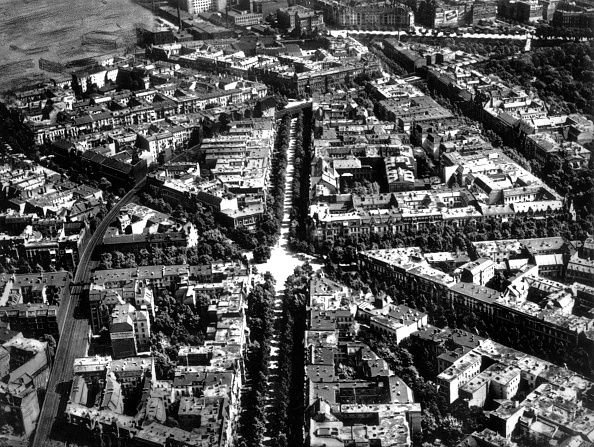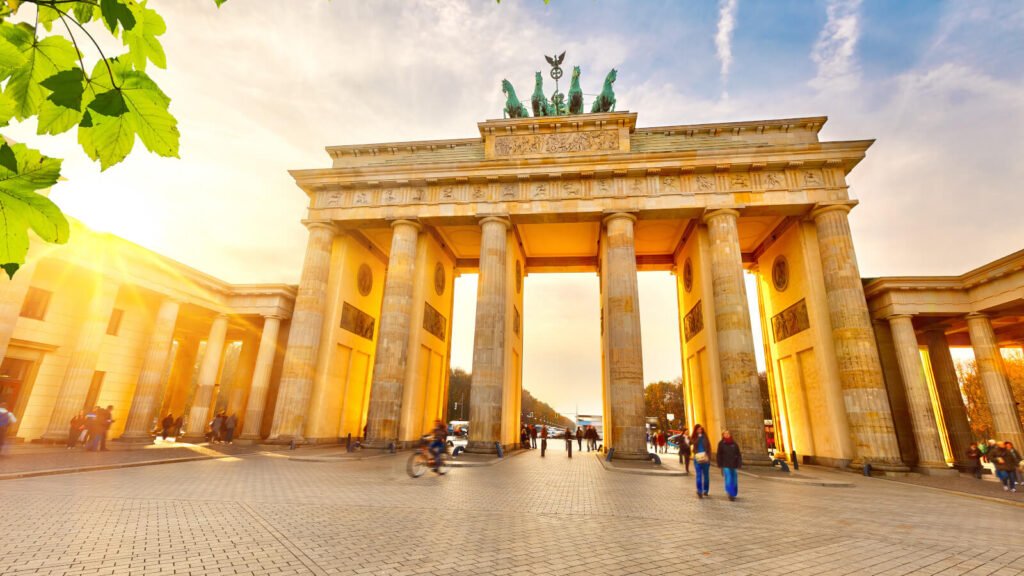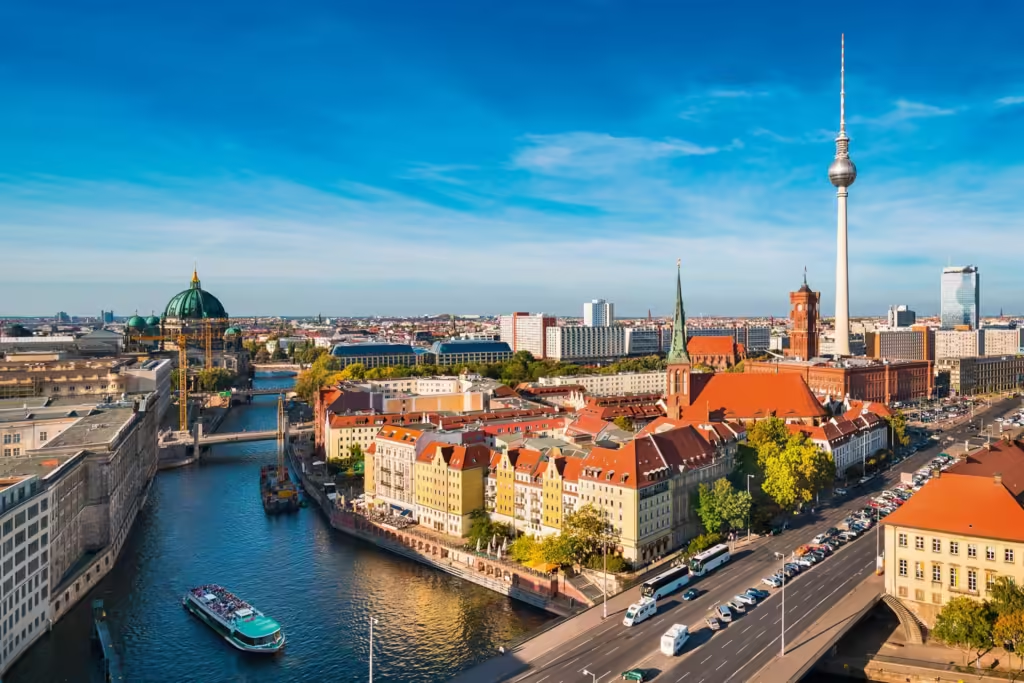Berlin Then and Now
Berlin Then
Berlin, the capital of Germany, has a rich historical and linguistic connection to Slavic languages, particularly due to its location in northeastern Germany.
Many place names in this region have Slavic origins, as the area was historically inhabited by Slavic-speaking peoples.
The city’s name, “Berlin,” is believed to come from the Old Polabian word “berl-” or “birl-,” which means “swamp,” reflecting the region’s landscape.
This Slavic influence is also visible in the names of several of Berlin’s boroughs and neighborhoods.
Five of the city’s twelve boroughs—Pankow, Steglitz-Zehlendorf, Marzahn-Hellersdorf, Treptow-Köpenick, and Spandau—have Slavic-derived names, as do twenty-two of its ninety-six neighborhoods, such as Altglienicke, Köpenick, and Prenzlauer Berg.

The use of suffixes like -ow, -itz, -vitz, and prefixes like Windisch and Wendisch is characteristic of the Germanization of Slavic place names.
This linguistic imprint reflects the historical blending of cultures and the evolution of the region over centuries.
Related Article: Paris Then and Now
Berlin History
Berlin, Germany’s capital, has a rich and complex history marked by its early foundations, significant political developments, and eventual reunification after decades of division.
The city’s origins date back to the early 13th century, with the founding of Berlin and Kölln, two settlements that later merged.
Positioned along the Spree River, these towns were strategically located to control trade routes between the East and West, and their establishment was facilitated by a resurgence of Germanic influence in a region that had once been dominated by Slavic tribes.
In the 13th century, Albert I the Bear, a Saxon leader, subdued the Slavic inhabitants and established the region as the margraviate of Brandenburg.
Related Article: London Then and Now
Over time, the city grew into a significant urban center, with its first recorded mention in 1244.
By the 14th century, Berlin became a hub for trade, joining the Hanseatic League and eventually becoming the capital of Brandenburg.
Berlin’s association with the Hohenzollern dynasty, beginning in the 15th century, solidified its political prominence.
Berlin continued to expand through the centuries, especially under the rule of Frederick the Great in the 18th century, who transformed the city with new buildings and improved infrastructure.
Related Article: Phnom Penh Then and Now
However, the city faced significant setbacks during the Napoleonic Wars and the subsequent reconstruction.
The 19th century saw industrialization and population growth, with Berlin becoming the capital of the newly unified German Empire in 1871.
The city’s population exploded, and Berlin became a cultural and intellectual hub, attracting thinkers like Hegel and Marx.
The 20th century brought both triumph and tragedy. After World War I, Berlin became the capital of the Weimar Republic, but it was soon overshadowed by the rise of Nazi power in the 1930s.
Related Article: Kathmandu Then and Now
The city’s Jewish population, once vibrant, was severely diminished by the Holocaust.
World War II caused widespread destruction, with thousands of civilians killed and the city’s infrastructure left in ruins.
Following the war, Berlin was divided into sectors controlled by the Allied powers, and this division solidified during the Cold War.
In 1961, the Berlin Wall was erected, physically and ideologically dividing the city into East and West Berlin.
Related Article: Colombo Then and Now

West Berlin became a symbol of freedom, while East Berlin, controlled by the Soviet-backed German Democratic Republic, was a center of communist rule.
The fall of the Berlin Wall in 1989 marked the beginning of the reunification process, symbolizing the end of communist control in East Germany.
The reunification of Berlin and the reunification of Germany in 1990 were pivotal moments in the city’s history, bringing the two halves of the city back together after nearly 30 years of division.
The post-reunification period posed numerous challenges for Berlin, including high unemployment rates, the need for infrastructure rebuilding, and overcoming the psychological barrier between East and West Berliners.
Related Article: Dhaka Then and Now
Despite these challenges, Berlin underwent a significant transformation, with large-scale construction projects revitalizing the city’s central districts.
The reunification of Berlin’s transportation system and government buildings helped restore its role as the political and cultural center of Germany.
As the capital of a reunified Germany, Berlin continues to be a dynamic and evolving city, drawing immigrants and tourists alike, and positioning itself as a key player in the broader European and global context.
Related Article: Lahore Then and Now
Berlin Now

Berlin, the capital and largest city of Germany is a vibrant metropolis that combines history, culture, and modern innovation.
With a population of over 3.85 million people, it is not only Germany’s largest city but also the European Union’s most populous city by population within city limits.
Berlin is located in northeastern Germany, surrounded by the state of Brandenburg, with the capital of Brandenburg, Potsdam, nearby.
Related Article: Karachi Then and Now
The city’s geographical location along the Spree River and its proximity to the Havel River contribute to Berlin’s distinct layout, with lakes, forests, and parks scattered throughout.
Almost one-third of the city’s area consists of green spaces, including rivers, canals, and lakes, making it a city with abundant natural beauty.
Historically, Berlin has played a central role in Germany’s political and cultural landscape.
Related Article: Istanbul Then and Now
After World War II, the city was divided into East Berlin and West Berlin by the Berlin Wall, which symbolized the division of Germany during the Cold War.
East Berlin became the capital of East Germany, while West Berlin was an enclave of West Germany.
Following the reunification of Germany in 1990, Berlin became the capital once again, marking a symbolic reunification of the nation.
Related Article: Riyadh Then and Now
This pivotal history, along with its central location, has led Berlin to be referred to as “the heart of Europe.”
Today, Berlin is renowned for its thriving economy, which is driven by sectors such as technology, media, biomedical engineering, and the automotive industry.
The city is a hub for creative industries, startups, and research, and it continues to attract global talent.
Related Article: Abu Dhabi Then and Now
Berlin’s public transportation system, which includes an extensive network of trains, buses, and trams, makes it easy for residents and visitors to navigate the city.
The city’s economy is further boosted by tourism, as its rich history, cultural attractions, and innovative spirit draw millions of visitors every year.
In addition to its economic strength, Berlin is home to a number of prestigious universities and cultural institutions.
Related Article: Doha Then and Now
Humboldt University of Berlin, Technische Universität Berlin, and the Free University of Berlin are some of the top educational institutions in the city.
The Berlin Zoological Garden, the most visited zoo in Europe, and the world-famous Babelsberg Studio, where many iconic films have been made, contribute to Berlin’s cultural significance.
The city also boasts several UNESCO World Heritage Sites, including Museum Island, the Palaces and Parks of Potsdam and Berlin, and the Berlin Modernism Housing Estates.
Landmark buildings like the Brandenburg Gate, the Reichstag, and the Berlin Wall Memorial remind visitors of the city’s complex past.
Geographically, Berlin lies in a low-lying region of marshy woodlands, part of the Northern European Plain.
Related Article: Ahmedabad Then and Now
The city’s landscape has been shaped by glacial movements during the last Ice Age, with valleys and plateaus providing a unique topography.
The Spree River flows through Berlin, with large lakes such as Müggelsee and Tegeler See enhancing the city’s natural appeal.
The highest point in Berlin is the Arkenberge Hills in Pankow, while the Müggelberge Hills, at 114.7 meters, are the highest natural elevation in the city.
This diverse geography offers a variety of recreational opportunities, from walking along the city’s lakeshores to exploring its wooded areas.
Related Article: Hyderabad Then and Now
In summary, Berlin stands as a dynamic city blending modernity with history.
It continues to evolve economically and culturally while preserving the rich heritage that makes it an essential part of Germany and Europe.
Whether exploring its historical landmarks, vibrant arts scene, or innovative industries, Berlin offers a unique and multifaceted experience to all who visit.
Related Article: Bengaluru Then and Now
FAQs
Berlin is best known for its rich history, particularly its role in World War II and the Cold War, marked by the iconic Berlin Wall.
It is also famous for its vibrant cultural scene, diverse architecture, and landmarks like the Brandenburg Gate and the Reichstag.
Berlin is famous for its historical significance as the capital of Germany, its symbolic reunification after the fall of the Berlin Wall, and its modern cultural influence in areas like art, music, and technology.
It’s also known for being a hub for innovation, startups, and a thriving creative scene.
Berlin is located in Europe, specifically in northeastern Germany.
Berlin is generally considered more affordable compared to other major European cities like London or Paris.
However, in recent years, the cost of living has risen due to increased demand, but it still offers a relatively low cost of living in comparison.






























